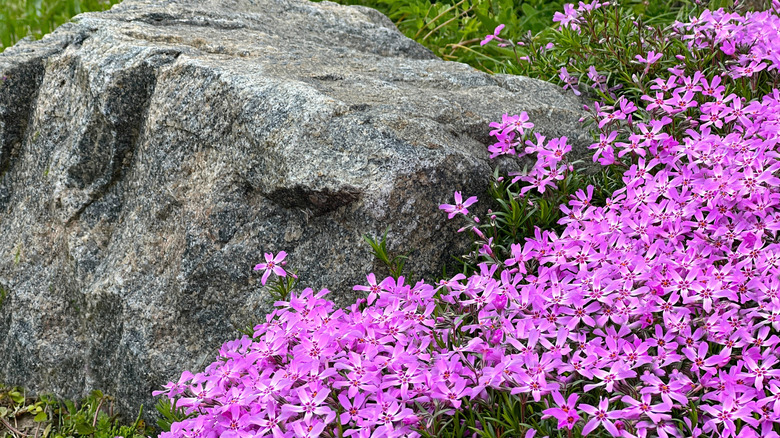Reliable Garden Companions To Plant With Ground-Covering Catmint
Catmint (Nepeta) is an excellent choice for gardeners who want hearty plants that add color and life to their garden landscape with a ground cover. Yet if you're new to the Nepeta family, don't think that catmint is the same as catnip (Nepeta cataria). Though similar in name and frequently confused with the feline favorite, catmint refers to a separate plant. Catmint is characterized by small purple and blue flowers that bloom from spring to summer on grey-green foliage. The name originates from cats' attraction to its scent. It's not uncommon to see catmint as it's a lovely, showy flower perfect for a spring border garden. If you want to add it to your garden, what should you plant alongside this quick spreader? Reliable companions for catmint include creeping phlox, ice plant, and pollinator-friendly plants such as bee balm.
If you close your eyes and picture an English garden, there's a chance you might get a glimpse of a catmint's lavender flowers. English gardens are replete with catmint, and it is featured in gardens created by one of England's most prominent designers Gertrude Jekyll. Drought-tolerant after it's established, catmint is a perennial that can thrive in most garden soils. While it enjoys the sun, catmint grows well in partial shade, spilling over containers and walkways. Not only is it repellent to pests such as aphids, but it's also deer-resistant. Catmint's simple care needs and no disease concerns let even the most novice gardener cultivate a beautiful flourishing garden, especially when planted alongside these companion plants.
What to grow as a catmint companion
With catmint as a ground cover, you have the foundation for a rich pollinator paradise, especially if you want to attract butterflies to your garden. Butterflies won't be the only visitors, as hummingbirds and bees also appreciate catmint. Grown with the pollen-packed perennial, creeping phlox, the combination is a winning duo that thrives with neglect. In addition, the varying color palettes of creeping phlox, from pink to white, let you create an ornamental garden glimmering with beauty. Sedum and ice plant are also suitable catmint companions, each also featuring drought-tolerance, deer-resistance, and pollinator appeal. Each companion flower is native and non-invasive, so they won't hurt adjacent plants either.
Catmint is also a great companion plant to grow near rose bushes. As a ground cover, catmint's value to rose gardeners is as a filler plant and a way to camouflage any less-than-perfect foliage at the bush's base. Roses also have a pest fighter when planted alongside this plant, thanks to the pest-deterring ability of catmint. Aphids and beetles avoid catmint, the presence of which can encourage them to stay away from your roses, as well. If an herb garden is your focus, catmint can be just as useful, growing well with thyme, rosemary, and sage. Its versatility will have you wondering how you will use it next.

